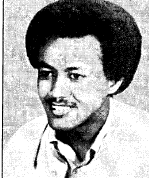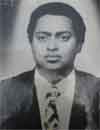
Researched and compiled by Resoum Kidane 22-5-2019
This section briefly looks at the development of nationalistic sentiments among Eritreans students who pursed their higher education in 1950s and 1960s. The revival of Eritrean nationalism among Eritrean students has history back to the 1950s when political repression intensified in violation of the UNResolution 390-A(V) that had established Ethiopian–Eritrean Federation in 1952. It is believed that founders of ENASA among those students who were actively participated in the students movement in Eritrea, Ethiopia and abroad during the 1950s and 1960s
In the 1950s and early 1960s students who received scholarship in the Middle East, Europe and Ethiopia played a great role in publicizing the Ethiopia government illegally annexed Eritrea in 1962. Regarding this Amar(2015) states that Eritrean students in Cairo organized many anti-Ethiopian demonstrations during the 1950s and early 1960s which influenced students in Asmara The most significant demonstrations of that early period were the ones staged in May 1962 and in March 1965.
Other students who received scholarship at Beirut University and elsewhere in European country also involved in publicizing the Ethiopia government illegally annexed Eritrea. According Hazell(2018 ) Dr Petros and Dr Teame who were students in Switzerland and Beirut respectively, distributed propaganda protesting at the annexation of Eritrea by Ethiopia whilst attending the student conference in Bologna in 1964.. At that time Dr Petros represented Switzerland, while Teame was representing the Middle East
Eritrean students at Halie Selasse I University also started involving in the Eritrea political issues following the unilateral dissolved of Eritrea –Ethiopia federation in 1962. Regarding this Hueri who was a student at HSIU in the early 1960s in his book states that , in 1963 a clandestine group was founded by Tekie Mebrahtu, Tsige Asfaha, and Herui (the author) from the University College, Girmay Gebremeskel from the Engineering College in protest to the Emperor's policy of annexation of Eritrea. Their early meetings were held in Dr Nerayo Tesfamichael's room. During the same year, they organized cells in the Building and Engineering and the Agricultural colleges. In 1963, they merged the cells in the mentioned colleges into one organization; at which point they were joined by Naizghi Kiflu and Girmay Bekhit, who functioned as contact persons with other cells in Addis Ababa. The aim of the university cell was to write leaflets and distribute them in Addis Ababa and Asmara during their vacation period.
Kidane Kiflu who was a student at Halie Selasse I University in 1962 also prepared a document describing the illegal annexation of Eritrea by Ethiopia and that the Eritrean people facing brutal suppression by the Haile Selassie government and had launched an armed struggle to make their country free. Many copies were printed and made ready for distribution. “At that time, African Foreign ministers were meeting at Africa Hall (ECA) and Kidane’s Plan was to distribute the document there. Mr. Grady, a radical American academic who also was a teacher of Kidane at the university drove us to the Conference hall and we carried the documents from the car and placed them at the entrance of the hall where the diplomats were to meet. All those who saw thought we were employees of the ECA engaged in preparation of the conference. After placing the documents on the tables of the conference hall we returned to the car and drove out of the building. We were neither stopped by the guards nor by the employees: mission accomplished. (emnetu)
In 1967 the University Students Union of Addis Ababa (USUAA formed. Although the union in 1967 passed a resolution condemning the Eritrean movement as “ a reactionary and sectarian ) it played a key role in developing a strong solidarity between Eritrean and Ethiopian progressive students in the campus. In late 1960s the progressive students within the University Students Union of Addis Ababa were strongly influenced by revolutionary internationalist ideology, the Paris riots of May 1968, as well as by African students who were on scholarship at the university college of Addis Ababa from other African countries. According to Petros, the Eritrean progressive students came to realize that if the oppressive feudal system was replaced by a socialist Government the problem in Eritrea could be solved peacefully based on the right of people to self-determination The Eritrean university students saw a light at the end of the tunnel and became very active in the Ethiopian students’ movement. Thus the Addis Ababa University became the melting pot of revolutionaries. It brought together students from different nationalities. (Petros Tesfa Giorgis (2007))
Mesfin Habtu
Mesfin Habtu was one of those Eritrean progressive students at Haile Sellasie 1 University Petros describes Mesfin Habtu as follow:
”Freshmen students like Mesfun Habtu gave the student movement a new revolutionary culture. Mesfin was exceptionally gifted at concocting revolutionary songs during demonstrations and rallies in the university campuses. Songs such as “Fano Tesemara en’de Ho Chi Minh en’de Che Guevara” became popular. Mesfun Habtu had been a rising star and left for the USA during the crackdown. Some observers said that he was not welcomed by the Ethiopian Students Union in North America (ESUNA) because of his radical views. He was found hanged, under suspicion circumstances, in his room in the States. Sadly the death of Mesfin was a great tragedy for the Eritrean progressive students and for the Eritrea revolution in the 1970
Petros adds that in late 1960s the Haile Sellasie 1 University students were extremely concerned at the poverty and lack of development that prevailed in Ethiopia. Progressive Ethiopian University students were inspired by the teachings of Marx and Lenin and started to see in socialist ideology as a way out of poverty and oppression. This is also confirmed by Bahru Zwed (2010) who states that in one student demonstration in protest at government policy, the students were met by the President of the Senate General Abey Abebe. Bahru Zwed recalls Temesgen Haile shouting: “Is poverty a crime“.
.
Temsegen Haile

As mentioned earlier in 1967 the USUAA passed a resolution condemning the Eritrean movement as “ a reactionary and sectarian, because of this attitude of USUAA, in 1970 In reaction to this and other factors could be in 1970a clandestine Eritrean Marxist Group (Teihsha) in the campus was formed. Temsegen Haile who was at one time president of USUAA was among the founders of Teihsha) which affiliated to the EPLF.
According Petros(2007), Temsegen Haile after graduation he was working for the ministry of mines as a surveyor, he used to travel to Eritrea and distribute the Eritrean paper “Tihisha” in Asmara to members of EPLF cells. . He was apparently arrested in Addis Ababa on suspicious of developing secret links with the Eritrean Front, and was tortured to death. It is believe that he either committed suicide by jumping off a tall building or was thrown off by security police (25).
Petros Yohannes and Temsegen Haile were the first English editors of the journal struggle (Teihsha) which was published by the clandestine Eritrean Marxist group.
Petros Yohannes
Petros Yohannes who was co-editor of the journal struggle (Teihsha) left to USA for further studies and was the main author of the book titled “In defence of the Eritrean revolution” in reaction to the Ethiopian Student Union in North America (ESUNA) . The book was published by AESNA, 1978.. The book was written in defence of the Eritrean revolution : against Ethiopian social chauvinists when the ESUNA insisted that the Eritrea question is not a colonial question.
ESUNA was founded in the early 1950s to provide an early resource for newly arrived Eritreans and Ethiopians. It was also a forum for the contestation of Eritrean nationalism, then called “The Eritrea question” Following the lead of the Addis Ababa-based National Union of Ethiopian University Students (NUEUS)which in 1967 passed a resolution condemning the Eritrean movement as “reactionary and sectarian”. ESUNA adopted a similar anti Eritrean position in 1969. (Kibreab)
Beyan Negash (2007) EUSNA chose not to condemn the massacre of ONA for a concern of appearing to legitimize the Eritrean Liberation Front (ELF).
In reaction to the ESUNA refused to condemn the massacre of 625 Eritreans who were killed in the village of Ona on December 1, 1970, the Eritrean students in North America who were member of the ESUNA split and formed their own association called ENASA in 1970 which will be discussed in the next section.
ehrea.org © 2004-2017. Contact: rkidane@talk21.com | ||||